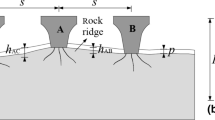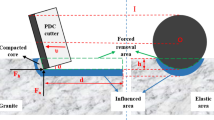Aiming at the problem of low efficiency of breaking Igneous rock, the models of breaking Igneous rock under cut-impact loads by spherical cutter, wedge cutter, and conical cutter were established respectively based on rock mechanics and finite element theory, and the Igneous rock breaking processes of three types of cutter under different combinations of impact parameters are simulated. The variation curves with impact parameters of Igneous rock breaking depth and volume, mechanical specific energy, and average tangential force of cutters are subsequently obtained, and the influence of cutter types, impact frequency, impact force on rock breaking efficiency were analyzed. Moreover, the mechanical properties of the cores collected from Hashan block and Mulei block in Junggar basin are analyzed by expariments under the condition of confining pressure. When the confining pressure reaches 60 MPa, the compressive strength of HS-3 and ML-3 rock samples reach 730.72 MPa and 301.75 MPa respectively. The results show that the impact resistance of spherical cutter is the best. When the weight of bit is 600 N and cutting speed is 1000 mm/s, the rock breaking efficiency of spherical cutter is the lowest, followed by conical cutter, and the wedge cutter is the highest. The drilling bit used in breaking Igneous rock under cut-impact loads should be a combination of these three types of cutters, which could improve the rock breaking efficiency by impact operation, and ensure the service life of bit. The results could provide basis for the design of drill bit and the parameters selection of impact tools for Igneous rock.









Similar content being viewed by others
References
D. Gumich, M. Pak, A. Lomov, et al. New ridge diamond elements improve PDC bit efficiency. Proceedings of the SPE Russian Petroleum Technology Conference, 2017. – pp. 1-10. Moscow, Russian.
L. Barnett, M. F. Dushaishi, M. F. M. H. Khan. Experimental investigation of drillstring torsional vibration effect on rate of penetration with PDC bits in hard rock. Geothermics, 2022, 103, 102410.
D. Crane, Y. Zhang, C. Douglas. Innovative PDC cutter with elongated ridge combines shear and crush action to improve PDC bit performance. Proceedings of the SPE Middle East Oil & Gas Show and Conference. Manama, Kingdom of Bahrain . 2017.
J. B. Zhang, Z. Y. Wang, W. G. Duan, et al. Real-Time Estimation and Management of Hydrate Plugging Risk During Deepwater Gas Well Testing. SPE Journal, 2020, 25(6), 3250-3264.
B. J. Sun, W. Q. Fu, N. Wang, et al. Multiphase flow modeling of gas intrusion in oil-based drilling mud. Journal of Petroleum Science and Engineering, 2019, 174, 1142-1151.
B. Yu, K. Zhang, G. Niu, et al. Real-time rock strength determination based on rock drillability index and drilling specific energy: an experimental study. Bulletin of Engineering Geology and the Environment, 2021, 80, 3589-3603.
C. Fu. Study of mechanism and experiment for rotary-cutting bit (Ph.D. Thesis). Southwest Petroleum University, China, 2016.
C. Zha, G. Liu, J. Li, et al. The rock breaking mechanism of the compound percussive-rotary drilling method with a PDC bit. Petroleum Drilling Techniques, 2017, 45(2), 20-24.
X. Jiang, D. Zou, J. Wang, et al. Experimental study of the prediction model for impact load on PDC cutters. China Petroleum Machinery, 2014, 42(4), 1-3, 15.
S. Li, T. Yan, W. Li, et al. Torsional impact rock breaking mechanism of PDC bits and their experimental analysis. Journal of Yangtze University (Natural Science Edition), 2014, 12(2), 48-51, 65.
Z. Cheng, M. Sheng, G. Li, et al. Cracks imaging in linear cutting tests with a PDC cutter: characteristics and development sequence of cracks in the rock. Journal of Petroleum Science and Engineering, 2019, 179, 1151-1158.
J. Li. Study on rock-breaking technology of PDC bit under Torsional impactor (Ph.D. Thesis). Yangtze University, China, 2018.
B. Liu, P. Ni, X. Tan, et al. Research on rock breaking efficiency of rotary punching drilling rig. Journal of Mechanical & Electrical Engineering, 2020, 37(7), 801-805.
M. Krivtsov, E. Pavlovskaia, M. Wiercigroch. Impact fracture of rock materials due to percussive drilling action. Proceedings of the XXI International Congress of Theoretical and Applied Mechanics, 2004, pp. 15-21. Warsaw, Poland.
A. Olusegun, M. Wiercigroch, E. Pavlovskaia, et al. Influence of Contact Force Models on the Global and Local Dynamics of Drifting Impact Oscillator. Proceedings of the 8th World Congresson Computational Mechanics, 2008, pp. 62-64.
R. Shan, H. Wang, Y. Yang. Some laws of rock breakage under impact by spherical indenter. Chinese Journal of Rock Mechanics and Engineering, 1996, 15(S1), 564-567.
L. Hu. On the mechanism of the dynamic fracture processes of rock under impulse loading (Ph.D. Thesis). Central South University, China. 2005.
Y. Lin, T. Shi, R. Li, et al. Simulation of impact force and penetration rate of air hammer bit drilling. Chinese Journal of Rock Mechanics and Engineering, 24(18), 3337-3341.
H. Zhu, Q. Liu, J. Deng, et al. Rock-breaking mechanism of rotary-percussive drilling. Journal of Basic Science and Engineering, 2005, 20(4), 2012. – 622-631.
I. Asonov, I. Berinskiy, J. Ing, et al. Brittle fracture of rocks under oblique impact loading. Proceedings of XXXVIII International Summer School-Conference, 2010, pp. 50-56.
S. Li, T. Yan, W. Li, et al. Mechanism experimental study of rock breaking assisted with high frequency harmonic vibration and impaction. Journal of China University of Petroleum (Edition of Natural Science), 2015, 39(4), 85-91.
L. Xuan, Z. Guan, H. Hu, et al. (2016). Design and application of experimental apparatus for rock breaking by rotary percussion. Oil Drilling & Production Technology, 2016, 38(1), 48-52.
Y. Yan, Z. Guan, L. Xuan, et al. Experimental study on rock breaking efficiency with a PDC bit under conditions of composite percussion. Petroleum Drilling Techniques, 2017, 45(6), 24-30.
Y. Yang, L. Chen, M. Lin, et al. The invention of a cut-impact composite drill bit. China: 2012, CN102678055A.
S. Xie, C. Cai, Y. Yang, et al. The invention relates to a controllable electromagnetic driven impact-cut composite drill bit and a method. China: CN111236848A. 2020.
X. Zhu, W. Liu. The rock breaking and ROP rising mechanism for single-tooth high-frequency torsional impact cutting. ACTA PETROLEI SINICA, 2017, 38(5), 578-586.
D. Yu, Y. Ding, Z.Y. Tan, et al. Experimental research on rotation-percussion drilling of diamond bit based on stress wave. IOP Conference Series: Earth and Environmental Science, 2020, 558(2), 032005.
D. Zou. The development of new PDC cutting elements. Petroleum Drilling Techniques, 2003, 31(3), 4-6.
S. Yang. Research and experimental evaluation of conical PDC tooth. Oil Field Equipment, 2015, 44(6), 38-42.
S. Zhang. Development of rock breaking simulation experiment system of petroleum bit based on ABAQUS (Ph.D. Thesis). Xi’an Shiyou University, China. 2020.
G. Xiong, B. Xi, Y. Wu, et al. Numerical study on distribution of temperature field of dry hot rockunder hot shock. Journal of Taiyuan University of Technology, 2018, 49(6), 820-826.
E. Kenneth, S. C. Russell. Innovative ability to change drilling responses of a PDC bit at the rigsite using interchangeable depth-of-cut control features. Proceedings of the IADC/SPE Drilling Conference and Exhibition. Texas, USA. 2016.
J. Zhang. PDC shock resistance and structural parameters optimization research (Ph.D. Thesis). Wuhan University of Technology, China. 2011.
L. Lv. Rock breaking mechanism and computer simulation of hybrid drill bits (Ph.D. Thesis). Xi’an Shiyou University, China. 2020.
H. Zhang. Structural design and test of mechanical rotary percussion drilling tool. China Petroleum Machinery, 2020, 48(12), 9-14.
B. Zhang, N. Lu, Y. Guo, et al. Modeling and analysis of sustained annular pressure and gas accumulation caused by tubing integrity failure in the production process of deep natural gas wells. Journal of Energy Resources Technology, 2022, 144(6), 063005.
T. Lu. Simulation analysis and experiment research on impact fragmentation of single indenter and rock under low power condition (Ph.D. Thesis). China University of Geosciences (Beijing), China. 2015.
Y. Li, L. Yu, T. Zhang, et al. Numerical simulation of rock breaking mechanism for compound percussion drilling. Journal of system simulation, 2019, 31(11), 2471-2476.
H. Zhang. Research on the adaptability of ROP improvement technique by self-oscillating rotary impact drilling (Ph.D. Thesis). China University of Petroleum (East China), China. 2018.
Y. Li, T. Zhang, Z. Su, et al. Simulation study on compound percussion frequency matching characteristics. China Petroleum Machinery, 2019, 47(9), 30-36.
R. Teale. The concept of specific energy in rock drilling. International Journal of Rock Mechanics and Mining Sciences. Geomechanics Abstracts, 1965, 2(1), 57-73.
C. Li, C. Gu, R. Li, et al. Study on wear analysis of PDC cutters in western of Nanliang Oilfield in in Ordos Basin. Drilling & Production Technology, 2012, 35(6), 71-74.
Z. Fu, M. Tergeist, A. Kueck, et al. Investigation of the cutting force response to a PDC cutter in rock using the discrete element method. Journal of Petroleum Science and Engineering, 2022, 213, 110330.
W. Q. Fu, Z. Y. Wang, B. J. Sun, et al. Rheological Properties of Methane Hydrate Slurry in the Presence of Xanthan Gum. SPE Journal, 2020, 25(5), 2341-2352.
W. Q. Fu, Z. Y. Wang, L. T. Chen, et al. Experimental Investigation of Methane Hydrate Formation in the Carboxmethylcellulose (CMC) Aqueous Solution. SPE Journal, 2020, 25(3), 1042-1056.
Acknowledgement
This work was supported by the SINOPEC Key Laboratory Project “Experimental study on the mechanism of rock broken by coupling with cut and impact in deep hard strata” [number KL22066]. This study received funding from SINOPEC. The funder was not involved in the study design, collection, analysis, interpretation of data, the writing of this article or the decision to submit it for publication. All authors declare no other competing interests.
Author information
Authors and Affiliations
Corresponding author
Additional information
Translated from Khimiya i Tekhnologiya Topliv i Masel, No. 5, pp. 113–118 September–October, 2022.
Rights and permissions
Springer Nature or its licensor (e.g. a society or other partner) holds exclusive rights to this article under a publishing agreement with the author(s) or other rightsholder(s); author self-archiving of the accepted manuscript version of this article is solely governed by the terms of such publishing agreement and applicable law.
About this article
Cite this article
Jifei, C., Deyong, Z., Cheng, L. et al. Simulation Analysis of Igneous Rock Breaking Law Under Cut-Impact Load. Chem Technol Fuels Oils 58, 862–872 (2022). https://doi.org/10.1007/s10553-022-01461-w
Published:
Issue Date:
DOI: https://doi.org/10.1007/s10553-022-01461-w




